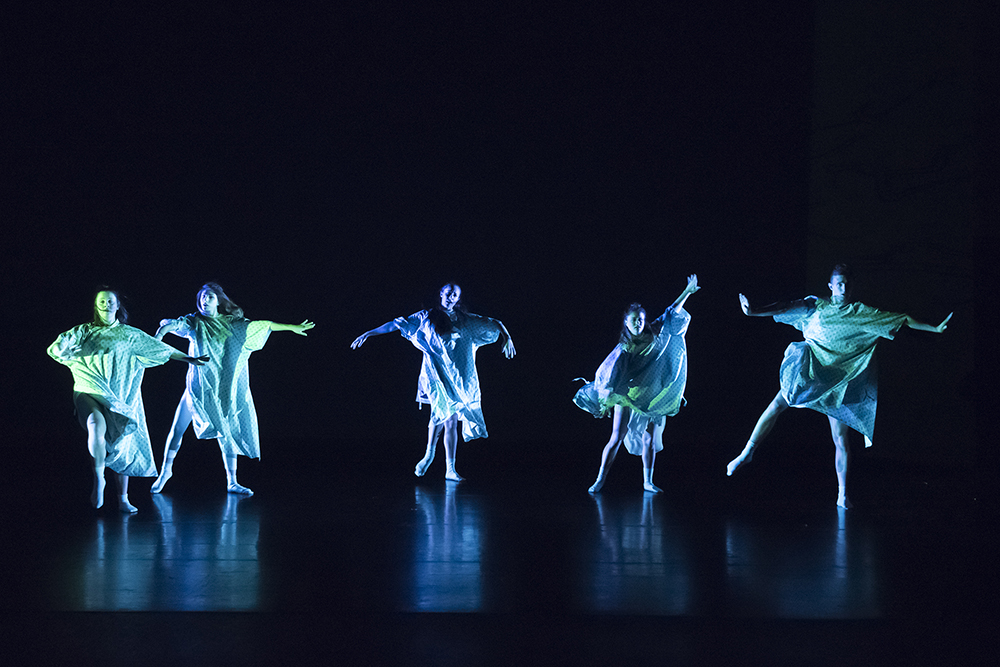Theatre community rallies, adapts during COVID-19 pandemic
Article body
As P.T. Barnum famously said, "The show must go on." With theatre closed, from Broadway to your local community playhouse, some artists have turned to digital or virtual platforms to continue to engage with audiences. Chase Bringardner, professor and chair of the Department of Theatre, comments on the current climate of the performing arts, what they might look like as a result of the pandemic, and how we can continue to support the art of the theatre and its performers.
"Performance finds a way. Performance always adapts because it's an integral part of the human experience, and it's how we all relate to each other and make sense of the world," Bringardner said.
How can live performance still exist in a time of social distancing?
The very nature of our current situation means that almost all live performance has ceased globally. For someone who believes strongly in the power of live performance to create community, this is a harrowing reality. With theatre closed, from Broadway to your local community playhouse, some artists have turned to digital or virtual platforms to continue to engage with audiences. There have been a number of live staged readings of plays and musicals through platforms like Zoom. Some theatre companies, like the Alliance Theatre in Atlanta and the Alley in Houston, have made their recordings of recently staged live productions available for streaming. Many others, from the Metropolitan Opera to the National Theatre, have opened up their vaults to share past live productions. Performance finds a way. Performance always adapts, as it's an integral part of the human experience and how we all relate to each other and make sense of the world. In many ways, these performances are charting unknown territory and redefining how we think of the very concept of performing live.
How are performers and artists making the best of new and different engagement with their audiences?
In exploring these new performative spaces, artists are forging new relationships with a variety of audiences. Many performers are in fact performing from their respective homes and inviting their audiences into the intimate spaces of their homes. This leads to a new relationship between the artist and audience that offers increased vulnerability as we see their bookshelves, pets, or even small humans in the background. While the mediums of Zoom and Instagram live can often make us feel distance, these performances force a different kind of intimacy, or risk, that offers audiences a new experience. While we are not physically in the same space together, there is a connection forged in that exchange. Rather than fully staged shows, artists are relying on their own ingenuity to make art with what they have around them. The recent broadcast of Saturday Night Live recorded on a series of cast member's Zoom rooms, featured props constructed from cardboard scraps and costumes pulled from home closets. This resourcefulness perhaps even might inspire audiences to even create their own home-based performances.
How is the performance community responding to assist and educate the public during this crisis?
Performance communities know how to rally and support one another. Costume shops throughout the country are hard at work sewing masks and creating gowns for first responders and hospital workers. Professional scene shops are helping to adapt ventilators and construct temporary structures to aid medical workers. Performers are creating public service announcements and helping to spread the word about the proper techniques to social distance and combat the virus. It is no accident that the primary way through which many people began paying attention to this outbreak was through the public statements of Tom Hanks and Rita Wilson. These performers, who personally grappled with the virus, went public with their diagnosis and brought critical awareness to the pandemic at a crucial time. They used the platform of social media to document their progress with the virus and to provide the public with visible, prominent examples of people making it through. They inspired us, informed us, and gave us hope.
What role do performers play, or should they play, in this crisis?
Performers have a vital role to play during this pandemic. Performers have platforms from which they can educate their fans and encourage them to abide by the guidelines suggested by scientists. Performers can also help to cut through the noise of all the various theories and rumors that swirl around such an event and can use the trust their audiences have in them to educate and inform. Artists have already performed streaming concerts from their homes to both uplift and raise money for vital causes. Moreover, artists have the unique ability also to document and comment upon the events going on through their respective mediums. They observe and create. They will help to craft the narratives, the histories of how we remember these times in the future. Just as playwright Tony Kushner wrote the incredible Angels in America in the 1990s to directly comment upon the global AIDS pandemic of the 1980s, this generation of playwrights and artists are already at work documenting these times and helping us to make sense of what at this point seems so unfathomable, big and uncertain. Artists reflect and reshape the world, and performers will be critical storytellers to help us make sense of what has happened.
What might the arts look like after all of this?
Moments like this will forever change the arts. For performance and theatre, I strongly believe that people will come out of this with a strong desire for live performance. They will seek out opportunities to create community together in shared public spaces and feel that physical presence with one another. I think live performance will thrive in a post-pandemic society. At the same time, this moment also forces us to wrestle with the presence of technology in our lives...technology that brings us together surely, but that also can make us feel more distant. I imagine the arts will also continue to grapple with the use and presence of technology in our lives interrogating many of the very platforms - like Zoom - that have become so much a part of our daily lives.
There's been a lot of talk about canceled sporting events, but what about canceled Broadway shows and other performances? How is this crisis impacting the larger performance community?
One thing that everyone must understand is that artists from across all fields are struggling. Most performers had shows canceled, rehearsals stopped, filming delayed without a safety net to fall back on. These individuals are at all levels of society, from the professional actors, directors, choreographers and designers on Broadway or in regional theatres to those who work at your local community theatres. They are the people on stage and off, on screen and off, those who build the sets, focus the lights, design the sound, sew the costumes, call the cues, run the box office, manage the front of house. The performance community works hard to support all its members, but they truly need the support of the entire nation to survive this moment. Theatre companies, symphonies, museums, etc. rely on their audiences and their communities for all sorts of support, including financial. Seek out organizations that support artists who are struggling. Pay for a streaming performance from those theatres that have made them available. All those streaming shows we are binging should remind each of us of the important role performance and performers play in providing us with stories to amuse, distract, educate and uplift. They desperately need our help in these harrowing times, just as those who work in our local restaurants and other service industries. Artists want to share their work with audiences again in shared public spaces and to again do the work of creating community together, but they need our help.
How can people continue to support artists in the uncertain times?
Seek out live theatre in whatever form you can, in all the various ways it's now available across digital and virtual platforms. Make a commitment to go and see live theatre, attend a concert, or visit a gallery when social distancing guidelines permit. Artists are here to help all of us navigate this uncertainty and to help usher us through to the other side of all of this. We just all have to pay attention and offer whatever support we can.
Auburn University is a nationally ranked land grant institution recognized for its commitment to world-class scholarship, interdisciplinary research with an elite, top-tier Carnegie R1 classification, life-changing outreach with Carnegie’s Community Engagement designation and an undergraduate education experience second to none. Auburn is home to more than 30,000 students, and its faculty and research partners collaborate to develop and deliver meaningful scholarship, science and technology-based advancements that meet pressing regional, national and global needs. Auburn’s commitment to active student engagement, professional success and public/private partnership drives a growing reputation for outreach and extension that delivers broad economic, health and societal impact.






